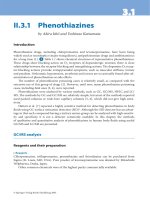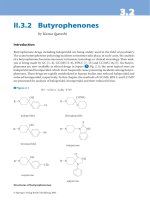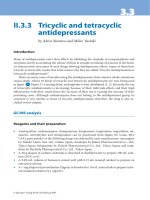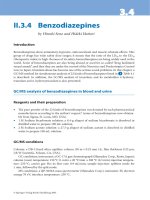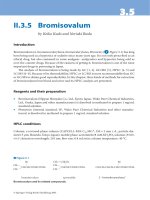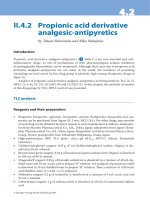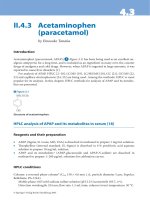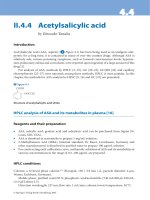Tài liệu Drugs and Poisons in Humans - A Handbook of Practical Analysis (Part 38) pptx
Bạn đang xem bản rút gọn của tài liệu. Xem và tải ngay bản đầy đủ của tài liệu tại đây (193.82 KB, 9 trang )
4.64.6
© Springer-Verlag Berlin Heidelberg 2005
II.4.6 Muscle relaxants
by Mayumi Nishikawa and Hitoshi Tsuchihashi
Introduction
Muscle relaxants can be classi ed into the peripheral-and central-acting drug types (> Table 6.1).
e drugs of the peripheral type are also called neuromuscular blocking agents. e peripheral-
acting muscle relaxants are being used for muscle relaxation upon endotracheal intubation and/or
general anaesthesia for surgical operation. e central-acting muscle relaxants are used for treat-
ments of painful muscle contracture caused by locomotorial disorders, and for relaxation of mus-
cle sti ness caused by psychotic tension or by neurosis. e cases of poisoning by the peripheral-
acting muscle relaxants o en take place, because of its strong suppressive action on respiration.
However, their poisoning is rare at the scene of medical treatments, because the risk is usually
avoided by arti cial respiration. Most of poisoning incidents due to the peripheral-acting muscle
relaxants are intentional and/or homicidal. In this chapter, therefore, analytical methods only for
the peripheral-acting muscle relaxants (
> Table 6.2) are dealt with. Since these drugs are quater-
nary ammonium salts, special care should be taken for their stability and e cient extraction [1].
TLC analysis
Reagents and its preparation
• Tubocurarine chloride, suxamethonium chloride ( succinylcholine chloride) and pan-
curonium bromide can be purchased from Sigma (St. Louis, MO, USA). For vecuronium
bromide, pure powder is not commercially available; ampoule solution for medical use
⊡ Table 6.1
Classification of muscle relaxants
muscle relaxants peripheral-acting non-depolarizing type
tubocurarine chloride (alkaloid type), pancuronium
bromide and vecuronium bromide (other types)
depolarizing type
suxamethonium chloride (choline type)
central-acting chlorphenesin carbamate, phenprobamate and
methocarbamol (carbamate type)
chlorzoxazone (chlorzoxazone type)
chlormezanone, dantrolene sodium, pridinol mesilate,
afloqualone, eperisone hydrochloride, tolperisone
hydrochloride, baclofen and tizanidine hydrochloride
(other types)
360 Muscle relaxants
(Musculax) can be obtained from Japan Organon-Sankyo (Tokyo, Japan). Each standard
compound is dissolved in methanol just before use
a
.
• Synthesis of succinylmonocholine iodide [2]: 2.3 g choline iodide and 5 g succinic anhy-
dride are mixed and fused for reaction by heating the mixture at 140 °C for 1–2 h in an oil
bath. A er cooling to room temperature, the excessive (not reacted) succinic anhydride is
washed with 100 mL acetone, succinyl monocholine iodide is crystallized in the mixture of
methanol/acetone/diethyl ether.
• A 0.85-g aliquot of bismuth subnitrate is dissolved in a mixture of 40 mL distilled water and
10 mL acetic acid to prepare “A” solution. A 8-g aliquot of potassium iodide is dissolved in
20 mL distilled water to prepare “B” solution. en, a mixture of A/B/acetic acid/distilled
water (1:1:4:20, v/v) is prepared ( Dragendor reagent).
⊡ Table 6.2
Peripheral-acting muscle relaxants
a) alkaloid type
tubocurarine chloride
b) choline type
suxamethonium chloride
c) others
panucuronium bromide
vecuronium bromide
361
• A 1-mL aliquot of 10 % platinic chloride solution is mixed with 25 mL of 4 % potassium
iodide and 24 mL distilled water ( iodoplatinate reagent).
TLC conditions
TLC plates: uorescent compound-containing silica gel plates ( Silica Gel 60 F
254
, Merck, Darm-
stadt, Germany).
Developing solvents
b
: ① 0.1 M hydrochloric acid solution/acetonitrile (1:1, v/v), ② meth-
anol/tetrahydrofuran/5 % formic acid solution (7:7:6, v/v), ③ methanol/chloroform/acetic
acid (5:4:1, v/v).
Detection reagents [3]: ④ Dragendor reagent, ⑤ iodoplatinate reagent.
Procedure
i. A solution specimen without dilution or a powder specimen a er dissolving in methanol is
spotted on a TLC plate.
ii. e spot is developed with a developing solvent in a glass tank.
iii. A er development, the plate is dried with a blower, and the spot is located under ultraviolet
light at 254 nm.
iv. e plate is sprayed with each reagent
c
. e color and R
f
value of the spot are compared
with those of the authentic compound for tentative identi cation.
Assessment of the method
In poisoning incidents with the muscle relaxants, the injection solution is occasionally le on
the spot; in such a case, TLC is a simple and rapid method for identi cation.
e R
f
values and the detection limits of the spots are shown in > Table 6.3.
⊡ Table 6.3
R
f
value and detection limits of the muscle relaxants observed by TLC
Compound R
f
value Detection limit (µg)
Developing solvents UV and reagents
➀➁➂
UV
➃➄
suxamethonium 0.25 0.15 0.02 – 0.1 0.1
succinylmonocholine 0.37 – 1.0
choline 0.46 – 0.1
pancuronium 0.47 0.38 0.10* – 0.1 0.1
vecuronium 0.51 0.47 0.27* – 0.1 0.1
tubocurarine 0.59 0.52 0.20* 0.3 0.3 0.2
*: tailing; –: no UV absorption;
➀
: 0.1 M HCl/acetonitrile (1:1, v/v);
➁
: methanol/tetrahydrofuran/5 % formic acid
(7:7:6, v/v);
➂
: methanol/chloroform/acetic acid (5:4:1, v/v);
➃
: Dragendorff reagent;
➄
: iodoplatinate reagent
TLC analysis
362 Muscle relaxants
Direct inlet MS analysis [4]
Reagents and their preparation
• A 1-g aliquot of iodine and 2 g potassium iodide are dissolved in distilled water to prepare
20 mL solution ( KI
3
).
• A 13.6-g aliquot of potassium dihydrogenphosphate is dissolved in distilled water to pre-
pare 100 mL solution. A 14.2-g aliquot of disodium hydrogenphosphate is dissolved in
distilled water to prepare 100 mL solution. Appropriate amounts of the above two solutions
are mixed to obtain phosphate bu er solution at pH 5.0.
MS conditions
Instrument: an MS QP-5050 mass spectrometer with a direct inlet probe (Shimadzu Corp.,
Kyoto, Japan); ionization: electron impact ionization (EI) and chemical ionization (CI) modes.
Probe conditions: temperature program at 40 °C/min from 30 to 350 °C.
Procedure
i. A 1-mL volume of urine, 1 mL of the phosphate bu er solution (pH 5.0), 100 µL KI
3
solu-
tion and 1 mL dichloromethane are placed in a glass centrifuge tube with a ground-in
stopper, which had been treated with silane, and shaken vigorously for 3 min for extrac-
tion.
ii. A er the tube is centrifuged, the organic phase (lower layer) is transferred to a small glass
vial with a silicone cap. e organic extract is evaporated to dryness under a stream of ni-
trogen at room temperature.
iii. e residue is dissolved in 50 µL dichloromethane and a 3-µL aliquot of it is placed in a
sample tube of the direct inlet probe followed by the evaporation of the solvent.
iv. MS analysis is performed in the EI mode and in the CI mode with isobutane as reagent
gas.
Assessment of the method
Fragment ions for the muscle relaxants observed in both EI and CI modes are shown in
> Table 6.4.
KI
3
was used as an ion-pairing reagent for extraction of the ionized drugs; other organic
ion-pairing reagents can be used [5], but KI
3
is suitable for the mass spectral measurements,
because the inorganic KI
3
does not almost interfere with the measurements.
363
LC/MS/MS analysis
Reagents and their preparation
• A 0.63-g aliquot of ammonium formate is dissolved in distilled water to prepare 1,000 mL
solution. e pH of the solution is adjusted to 6 by adding formic acid or ammonia water
(10 mM, pH 6.0).
• A 0.83-mL volume of concentrated hydrochloric acid is diluted with distilled water to pre-
pare 100 mL solution, followed by addition of 100 mL methanol (0.1 M hydrochloric acid
solution/methanol, 1:1, v/v).
LC/MS/MS conditions
Instrumental conditions; instrument: a Quattro LC/MS instrument (Micromass, Manchester,
UK); interface: electrospray ionization ( ESI); ionization: positive mode; capillary voltage: 3.7 kV;
cone voltage: 25 V; ion source temperature: 100 °C; collision gas: argon (2.3 e
–3
mbarr); collision
energy: 23 V.
HPLC column
d
: TSK gel VMpak-25 (75 × 2.0 mm i. d., Tosoh, Tokyo, Japan); mobile phase:
15 mM ammonium formate solution/acetonitrile (30:70, v/v); its ow rate: 0.08 mL/min.
Procedure
i. A 5-mL volume of methanol, 5 mL distilled water and 10 mL of 10 mM formate bu er so-
lution (pH 6.0) are passed through a Bond Elut CBA cartridge (Varian, Harbor City, CA,
USA)
e
to activate it.
ii. Urine or tissue supernatant
f
is directly poured into the cartridge; serum is diluted 2-fold
with distilled water, and a 1–3 mL volume of the solution is mixed with an equal volume of
10 mM formate bu er solution (pH 6.0), followed by application to the cartridge.
iii. e cartridge is washed with 2 mL distilled water.
iv. A target compound is eluted from the cartridge with 2 mL of 0.1 M hydrochloric acid solu-
tion/methanol (1:1, v/v).
v. An xed volume of the eluate
g
is injected into LC/MS/MS.
⊡ Table 6.4
Principal fragment ions of the muscle relaxants detected by direct inlet MS
Compound m/z (relative intensity, %)
EI Cl
suxamethonium 58 (100), 71 (30) 191 (100), 261 (45)
pancuronium 467 (100), 340 (40) 416 (100), 543 (70), 483 (30)
vecuronium 425 (100), 467 (50) 374 (100), 501 (75), 543 (20)
tubocurarine 298 (100), 594 (25) 264 (100), 306 (40), 320 (35)
LC/MS/MS analysis
